Automation is transforming quality assurance in fintech apps like PayPal and Razorpay.With increasing demands for speed, compliance, and security, test automation enables rapid deployments, real-time monitoring, and seamless CI CD testing integration. By combining QA automation, API testing, AI in testing, and performance testing tools, fintech companies can ensure robust, scalable, and secure digital experiences.
💡 Here’s what you’ll learn:
📌 Why QA automation is critical for fast, secure fintech app testing?
📌 Top challenges in automating APIs, CI/CD, and compliance workflows
📌 How test automation improves quality assurance for payment platforms
📌 The role of continuous testing in accelerating fintech release cycles
📌 Emerging AI-powered automation trends transforming fintech QA
Understanding Automation in Fintech Testing
Fintech applications like PayPal and Razorpay operate in fast-paced, high-stakes environments where accuracy, speed, and scalability are paramount. QA automation plays a crucial role in ensuring these platforms deliver secure and seamless user experiences.
Why Automation is Crucial in Fintech QA?
In the fintech sector, even a minor bug can result in financial losses or security breaches. The need for speed and coverage cannot be satisfied by traditional manual testing. This is where QA testing automation becomes essential.
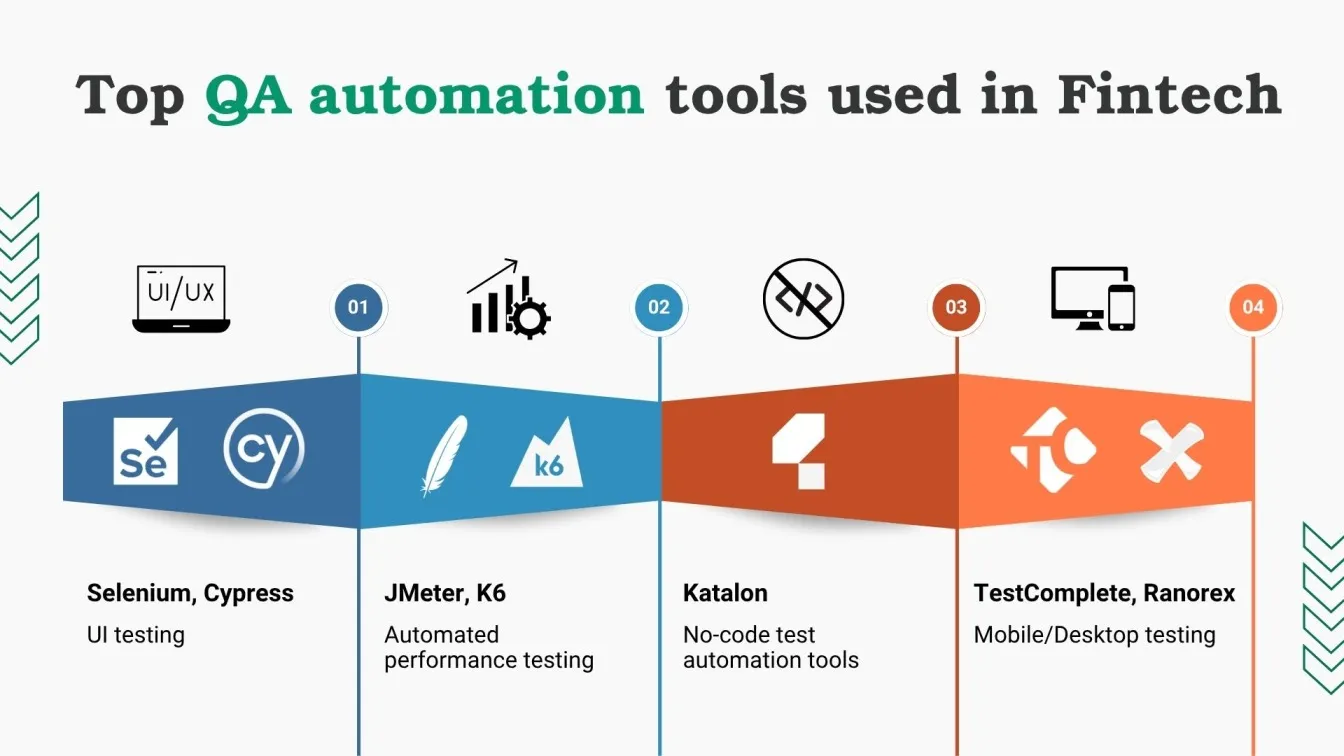
Key Benefits of QA Automation in Fintech Testing:
- Faster Releases: Enables quick delivery through CI/CD pipelines.
- Broad Coverage: Validates key flows like KYC, UPI, and payments.
- Reliable Regression: Detects issues by auto-retesting existing features.
- Compliance Ready: Ensures security and performance for regulatory needs.
Fintech relies on QA automation services and continuous integration testing for fast, secure releases. Using AI testing and cybersecurity penetration testing ensures reliable, compliant applications.
Key Challenges in Automating Fintech Applications
While QA automation accelerates testing efficiency in fintech, automating such applications comes with its own unique set of hurdles. Fintech apps like PayPal and Razorpay deal with sensitive data, real-time transactions, and complex integrations, all of which demand precision and robust validation strategies.
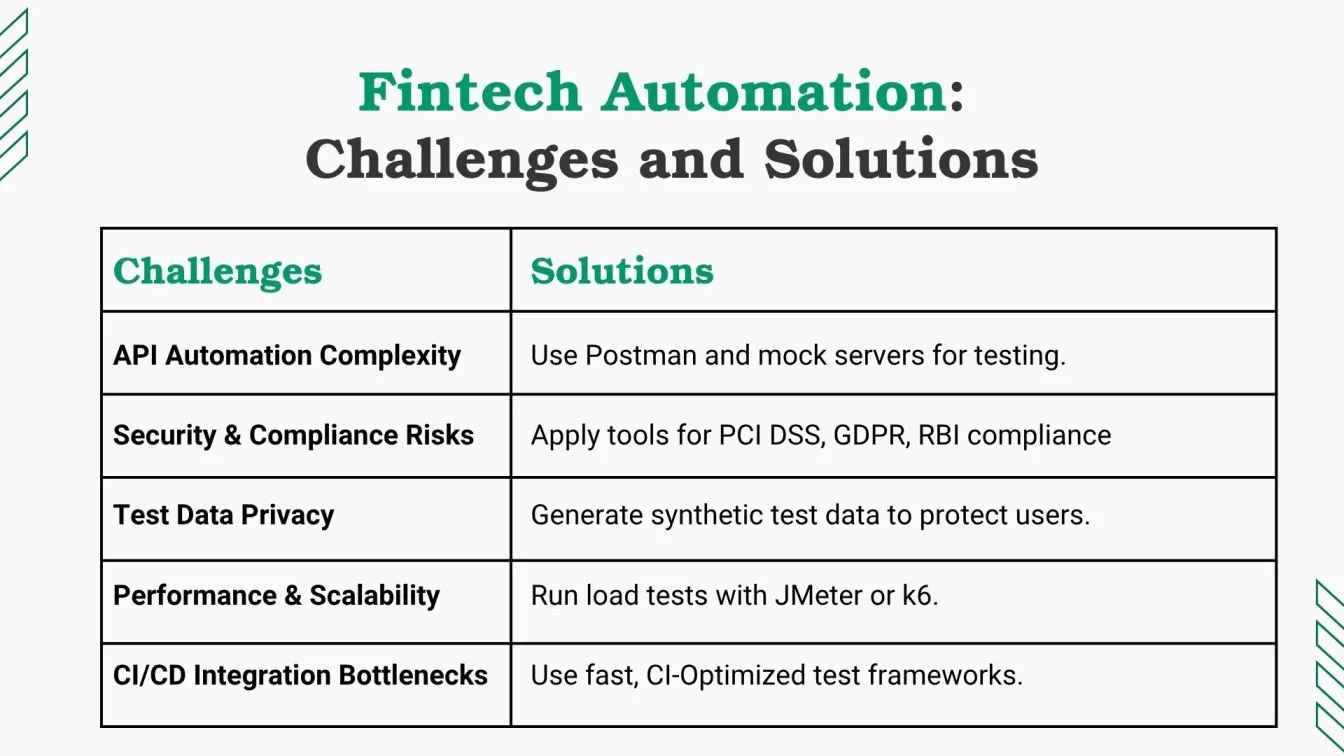
Fintech automation faces challenges that require QA automation testing services and continuous integration automated testing to ensure accuracy and compliance. Using a dummy API for testing, AI QA testing, and cybersecurity penetration testing strengthens security and test reliability.
How Test Automation Accelerates Quality Assurance in Payment Apps
Payment apps like PayPal and Razorpay handle thousands of transactions per minute across various payment methods, including credit cards and digital wallets. In the fast-paced fintech industry, manual QA cannot ensure the security protocols, reliability, and performance required for seamless payment gateway operations.
Test automation enhances speed and scalability while improving customer experience and supporting efficient customer support, making it essential for modern financial technology platforms.
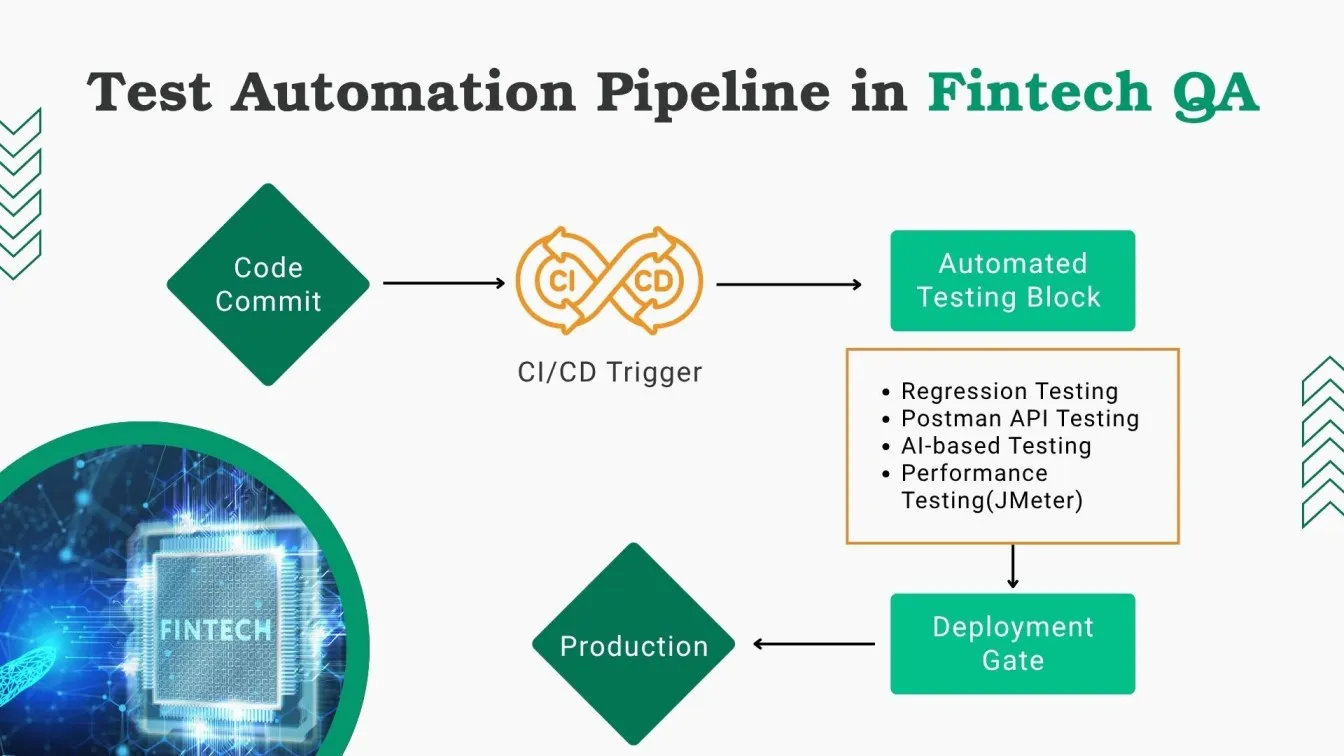
Key Ways Automation Speeds Up QA in Payment Platforms
- Regression Testing: Automate payment flows, KYC, refunds
- API Automation: Use Postman & dummy APIs for continuous coverage
- CI/CD Testing: Integrate automated tests into Jenkins, GitLab
- AI in Testing: Self-healing scripts, faster defect detection
- Performance Testing: Real-time checks using JMeter, k6
Test automation helps payment apps like PayPal process transactions securely and quickly. Using API automation, CI/CD testing, and AI self-healing scripts ensures reliable payment gateways and a better customer experience.
API Automation: Ensuring Reliable Transactions for PayPal and Razorpay
For payment giants like PayPal and Razorpay, APIs form the backbone of transaction workflows, KYC validation, refunds, wallet management, and UPI integrations. These APIs must perform flawlessly across environments and edge cases. API automation testing ensures every endpoint works as expected, securely and at scale.
Why is API Automation Critical in Fintech Testing?
Payment apps heavily rely on internal and third-party APIs. Even a minor failure can disrupt user trust or delay a transaction. Manual testing cannot scale for the volume, velocity, and complexity of fintech APIs.
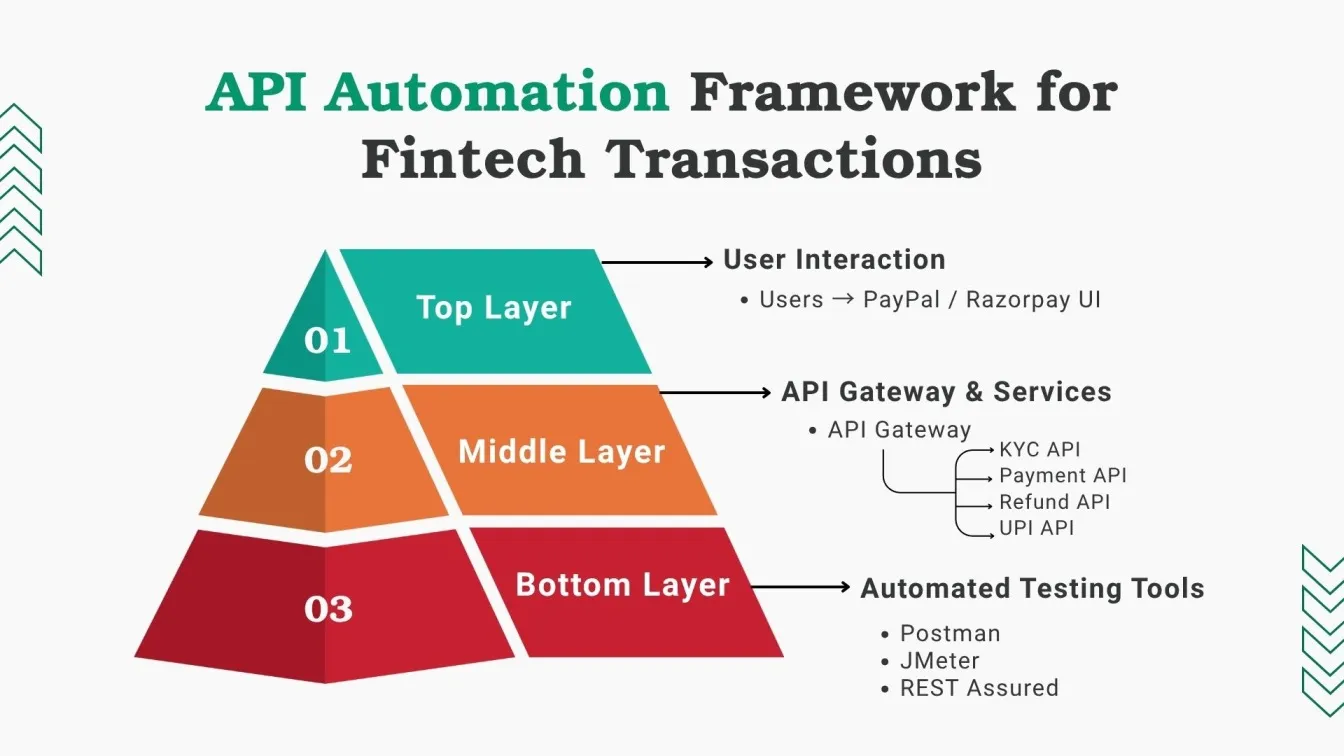
Benefits of API Test Automation in Payment Apps:
- Consistency in Test Execution: Automated API tests ensure repeatable and reliable validation with no human-induced variation.
- Improved Test Coverage: Covers a wide range of scenarios, including edge cases, failed transactions, and error codes.
- Speed with CI/CD: Integrated into CI/CD pipelines, API tests offer immediate feedback during every code push.
In fintech apps like PayPal and Razorpay, common API automation practices include using Postman for scripting and chaining requests, validating APIs with dummy data in pre-production, automating performance tests on high-traffic endpoints with JMeter or k6, and leveraging AI software testing to adapt test scripts to payload or schema changes automatically.
Implementing Continuous Testing in Fintech CI/CD Pipelines
Continuous testing in fintech CI/CD pipelines ensures rapid, secure, and reliable software delivery. By embedding automated tests across every stage from code commits to deployment, fintech apps like Razorpay and PayPal maintain high performance, regulatory compliance, and seamless user experiences.
What Is Continuous Testing in Fintech?
Automated test execution across the development lifecycle is known as continuous testing. Because of its close integration with CI CD pipelines, development, testing, and deployment may all take place at the same time.
In fintech, continuous testing is essential to prevent transaction failures that could lead to revenue loss or customer churn. It ensures real-time features like UPI and instant refunds receive instant feedback, while also providing traceable QA coverage required for regulatory audits making it vital for secure and compliant fintech operations.
Key Benefits of Continuous Testing for Fintech Apps
- Faster Feedback Loops: Automated tests immediately validate new code, reducing time-to-market.
- Higher Release Confidence: Issues are caught early, preventing defects in live payment environments.
- Improved Developer-Tester Collaboration: QA teams can align better with dev teams using shared continuous testing tools.
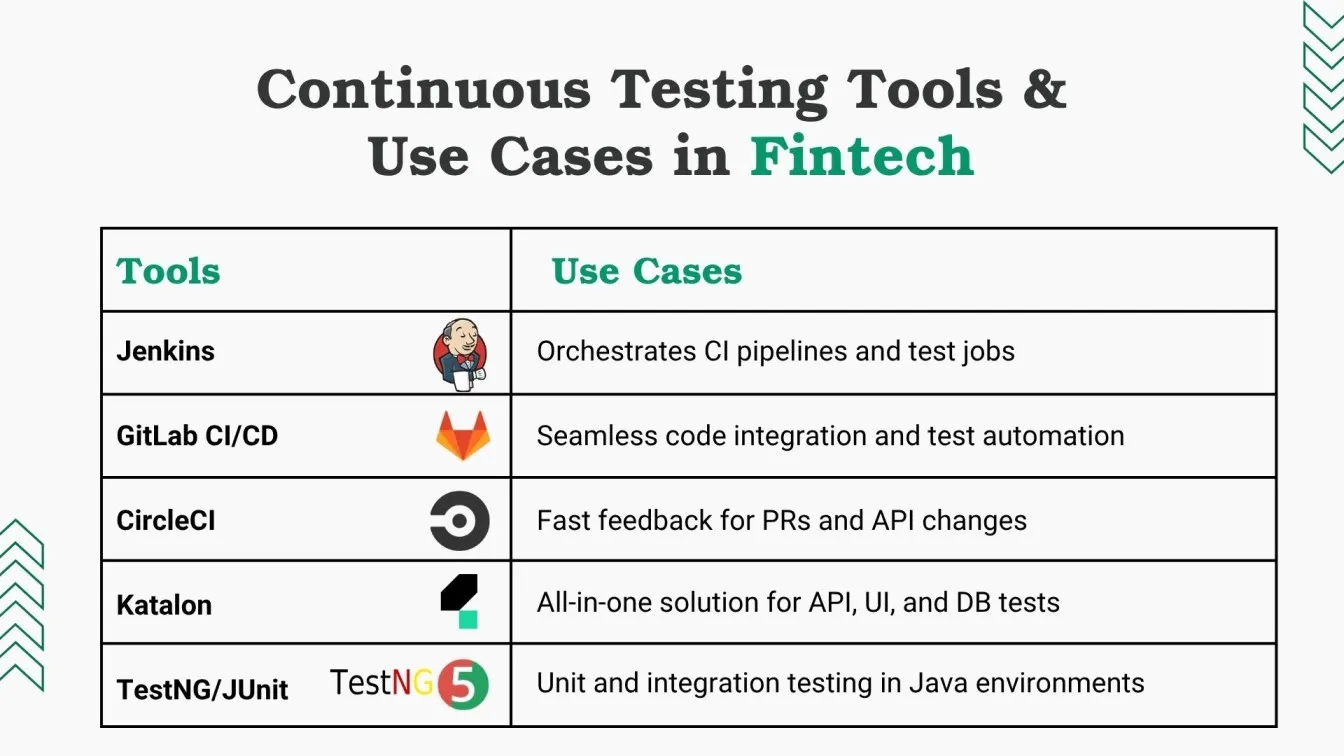
Steps to Implement Continuous Testing in Fintech CI/CD Pipelines:
- Set Up CI/CD Tools: Use Jenkins, GitLab, or CircleCI to automate builds, tests, and deployments.
- Integrate QA Automation: Automate UI, API, and performance tests using Selenium, Postman, and JMeter.
- Create Testing Environments: Use QA, staging, and dummy API setups for safe and realistic testing.
- Define Test Triggers: Run specific test suites (unit, regression, smoke, load) at each pipeline stage.
- Use AI Testing Tools: Improve coverage and script resilience with AI-based testing tools.
- Add Security Testing: Perform code scans and compliance checks (PCI DSS, GDPR) in CI stages.
- Track Testing Metrics: Monitor pass rates, execution time, and test coverage via dashboards.
Fintech apps use QA automation services and CI testing to ensure fast, secure releases. dummy APIs, AI in testing, and application security testing services boost coverage and compliance.
Performance Testing Automation for High-Volume Fintech Transactions
Apps like PayPal and Razorpay must handle thousands of mobile payments and online payments per second with seamless payment processing and payment integration. Automated performance testing ensures system scalability and precision under peak loads, safeguarding REST APIs, biometric authentication, and third-party checks.
This testing also supports critical compliance like KYC and AML monitoring, while improving customer service for digital currency and portfolio management platforms. Combined with unit testing, it helps prevent delays and failures in fintech transactions.
Why Performance Testing Is Vital in Fintech QA?
Fintech platforms must guarantee high availability, low latency, and stable throughput across:
- Peak transaction times (e.g., salary days, holiday sales)
- UPI-heavy loads from partner apps and merchants
- Multiple concurrent user sessions with a real-time database
Manual performance testing cannot keep up with this complexity. Automation brings speed, consistency, and scalability.
Latency checks measure response times and error rates to ensure consistent performance. Integrating these tests into CI/CD pipelines (e.g., Jenkins, GitLab CI) allows continuous monitoring of performance trends during every release.
Emerging Trends: AI-Powered Automation in Fintech Quality Assurance
API credentials, biometric login, and identity verification with greater speed and accuracy. It enhances user-centric features in personal finance apps and payment gateways, supporting smart payments, automated trading strategies, and high-frequency trading.
AI-driven testing improves customer and user experience with real-time updates, ensuring compliance through AI risk models and regulating automation in the evolving digital economy.
How AI Is Transforming QA Automation in Fintech?
AI enhances QA automation in fintech by auto-generating test cases, self-healing scripts, and detecting defects faster. It boosts test coverage, speeds up releases, and ensures secure, compliant apps.
AI-Driven Innovations in Fintech Testing:
- Smarter Test Generation: AI creates test cases from code, user flows, and bug history, reducing manual work.
- Self-Healing Scripts: Tools like Testim and Mabl auto-fix locators when the UI changes.
- Predictive Defect Detection: Machine learning identifies likely test failures to prioritize key regressions.
- AI in Performance & Security: AI monitors transaction speed and detects known security risks in real time.
AI testing tools are revolutionizing fintech QA by minimizing flaky tests, enhancing reliability, and increasing ROI. Platforms like Testim and Mabl offer self-healing and intelligent UI testing, while Functionize enables natural language test automation.
Applitools uses Visual AI for testing to catch UI issues, and Sealights offers predictive analytics to prioritize high-risk areas. Together, these tools help fintech teams release faster, safer, and more reliable applications.
Frugal Testing: Building Secure and Bug-Free Fintech Applications
Frugal testing is a cost-effective QA strategy that helps fintech companies build secure and bug-free applications without overspending on testing infrastructure. In a domain where applications like UPI platforms, payment gateways, and digital wallets demand precision and security, frugal testing focuses on maximizing test efficiency while minimizing costs.
By using open-source automation tools such as Selenium, Postman, JMeter, and REST Assured, teams can ensure comprehensive API testing, UI validation, and performance testing without relying on expensive commercial solutions.
This approach encourages the use of mock environments, synthetic data generation, and CI/CD-integrated test automation to detect issues early and reduce time-to-market. It also supports adherence to critical compliance standards like PCI DSS, GDPR, and RBI guidelines, which are essential for secure fintech operations.
For both startups and large-scale fintech enterprises, frugal testing provides a scalable path to ensure application security, stability, and performance, all while optimizing QA spend.
People Also Ask
👉 What are the best strategies to maintain test data privacy in fintech automation?
Use synthetic data, data masking, and role-based access to protect sensitive information during automated testing, ensuring compliance with GDPR and PCI DSS.
👉 How can synthetic data help improve fintech QA automation?
Synthetic data creates realistic but fake datasets, allowing safe testing of fintech workflows without exposing real customer information, improving test accuracy and security.
👉 What are the best practices for implementing test automation in fintech QA?
Key practices include automating critical test cases, integrating testing in CI/CD, using data-driven scripts, and running performance and security tests in pre-prod environments.
👉 How does risk-based testing optimize QA efforts in fintech automation?
Risk-based testing prioritizes testing critical fintech features like payments and KYC, focusing automation where it matters most to reduce errors and speed releases.
👉What metrics should fintech companies track to measure automation ROI?
Track test coverage, defect detection, test speed, and release time to measure how automation improves quality and speeds up fintech app delivery.





%201.webp)

